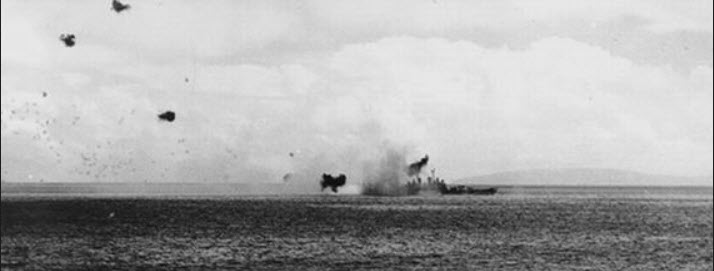
The "Lou" takes a Kamikaze at Leyte

Excerpts from Survivors of the Battle
Leyte Gulf Kamikaze Hit
Updated
09/10/2021
Home
Saga's
Ships Log Entry:
St. Louis was attacked by kamikaze aircraft off Leyte on November 27, 1944. Late that morning one aircraft made a suicide dive on St. Louis from the port quarter and exploded with its bomb on impact. Fires broke out in the cruiser's hangar area and spaces.
All crew members of 20 millimeter guns 7 through 10 were killed or wounded. A
minute later, a second burning enemy plane headed at St. Louis on the port beam.
The plane passed over number 4 turret and crashed 100 yards out. Soon, two more
enemy planes, both burning, attacked St. Louis.
The
first was splashed off the port quarter; the second drove in from starboard and
crashed almost on board on the port side. A 20-foot section of armor belt was
lost and numerous holes were torn in her hull. The ship took on a list to port.
Just after noon, still another suicide aircraft came in; it was shot down 400
yards astern. Finally, 10 minutes later, enemy torpedo planes attacked and. St.
Louis, maneuvered to avoid torpedo hits.
By 1 pm,
the cruiser was back on an even keel, all major fires were out, and salvage work
had been started. 15 dead; 1 was missing; 43 wounded.
Boatswains Mate 1/c Bernard J. RygeIski.
November 27, 1944:
A fueling-at-sea operation was scheduled for the, morning of Nov. 27, 1944
with a tanker at the hub of a circling ring of protecting battleships, cruisers
and destroyers. Everything was proceeding smoothly until enemy aircraft were
detected in the area.
All hands went to battle stations and the fueling was continued after some adjustments were made in the formation to meet the possibility of air strikes. Shortly thereafter a Japanese "Judy" rocketed from the clouds off the St. Louis' port bow. That was one of the most unforgettable moments of the war for Boatswains Mate 1/c Bernard J. RygeIski.
Explosion Blows Off Tail of Enemy Plane
"I was sitting on a hatch on the starboard quarterdeck talking to other
members of my repair party
when I heard a plane motor that sounded exactly like approaching planes sound in
the movies".
The plane was in a dive, and just as it started to pull out there was an
explosion and its tail fell off I guess its bomb must have been short fused or
something, pieces of the plane were drifting down toward the water.
"He must have been the leader of the attacking group for in about 10 minutes we heard that a formation or planes had been sighted off the port bow. From where I was standing I could see only two and these two disappeared in the clouds. I think the main attacking unit had split up into two units.
"I saw and noticed the battleship fueling had stopped and they had begun
to clear the tankers sides"
RygeIski continued, when our AA battery trained to port and opened up on a group
of four Jap planes.
"I saw only one of them though". It was a "Val", hit and
smoking, diving for our port quarter. On it came through the din. Then there was
a loud crash. The ship quivered and a big gush of flame and debris rose
high in the air.
"The next thing I knew I was almost thrown from my feet as the ship swung
rapidly in a tight circle. We were maneuvering to avoid a blazing "Hamp"
coming in at our port bow with the obvious intent of crashing. By the grace of
God and some good ship handling, he missed. He roared between the stacks and
jack knifed into the gulf less than 100 yards from where I stood. "He
came so close to us that I saw the pilot's face twisted in terrible agony, his
arms rigid over his head, hands clenched in pain.
'Plummeting Toward Me at 90 Degrees'
"Then I noticed mount one training forward. I glanced up and I saw a plane emerging from the overcast. A split second later it was plummeting toward me at virtually a 90-degree angle. There was no mistaking its course, so I said to myself 'This is it,' and I dropped to the deck as I had been instructed to do so many times before, covered my face with my hands, shut my eyes and said a little Prayer. All of my life passed in review in my mind in those few seconds.
"There was a muffled explosion", the ship staggered, then all was quiet It was as if a roaring tornado had suddenly been stilled. The ticking of my watch told me wasn't I dead so I peered between my fingers and what I saw made me smile Chris Portewig Boatswains Mate 1/c of Williamsburg, Va. was standing there soaked to the skin by the water thrown up by the plane. He had an empty powder can in his arms, and was staring in bewilderment. I guess he hadnít even know the plane was coming. This plane, a "Hamp" , had struck the ship a glancing blow, ripping off a section of armor plate before plunging into the sea and exploding. A third "Hamp" attempting to come in at the same time from dead astern had been flamed by the machine guns aft and pitched burning into the gulf.
Nineteen minutes later at 12:10 PM, to be exact a "Judy" dove at an extreme angle over the starboard bow and our AA battery brought it under fire. "It, looked to me as if he was trying to hit a destroyer off our starboard beam," Marine Cpl. Robert Goodwin recalled "As the bas...arid came across our bow pretty high, the gun I was on let him have it He only took a few rounds before his tail blew off, and down he went with a tremendous splash. explosion
The "Val" that-hit our stern came in upside down according to Gunner's Mate 3/c Alvin F. Brickner who with eight shipmates was manning a machine gun aft. "We followed the plane in until our line of fire was obstructed" and then I told the boys to take cover. Some of them lay down, others sought cover behind structures. I ducked down behind a shield and gripped some braces. There wasn't 't much time to wait. The plane was there almost as soon as I had grabbed the braces, and the next thing I knew there was a terrific explosion and I felt like I was suffocating and knew I was bleeding and that I would be burning too If I didnít get out of there.
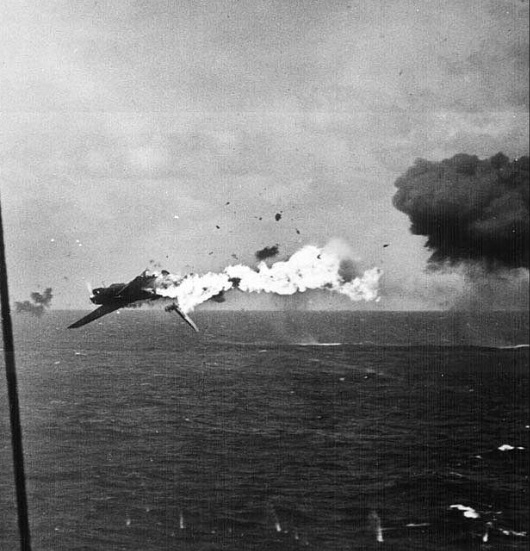
"The explosion had taken all the oxygen out of the air and I had been wounded by shrapnel in the right hand, arm both legs and back. A large fire burned not far from me. The Plane had penetrated to the second deck just forward of where I was. I decided to make a run for it through the flames. "As I burst through the blaze I nearly stepped on a buddy of mine. One of his arms and a leg were blown almost completely off. I tried to help him, but someone came up and told me to get down to the battle dressing station where they were taking care of the wounded." Brickner is the only member of his nine-man gun crew still serving on board the St. Louis. Five of the nine were killed and the remainder were seriously injured by shrapnel and concussion.
In the relatively short time of this engagement the St. Louis had shot down four planes, assisted in shooting down two more and had been damaged by two suicide's. As a result of this engagement, and after temporary repairs we returned to the States for final repairs
Of Note !
It is a matter of record that a marine officer Capt. Robert M. Richards of
Camden NJ., was the first person to identify the approaching formation as enemy
planes and to initiate early warning to the Commanding Admiral for this and
subsequent excellent work throughout the attack, Capt. Richards received the
Silver Star Award.
R.O. Hudgins, EM- CEM(T) E. Division
Pasadena, TX
Nov. 27, 1944 (Leyte Gulf AM)
Excerpt from his War Diary
Situation is this: Dawn finds Task Force refueling from a tanker.
The Task Force is in a large rotating circle formation, with a Destroyer ahead and one astern of the circle. The tanker is in the center, and the vessels are taking their turn at fueling. At about 1100 air defense is sounded. At 1138 I heard the weird drone of a diving plane and looked up just in time to see a Jap plane cut loose his bomb, which fell between us and the DENVER, not far off our port bow. A split second his wings came off and he crashed into the sea. Not a shot had been fired. Still a few seconds later all "Hell" broke loose.
Our guns fired rapidly at a plane which was hit time after time but it kept coming at us, it came down over the port side of the fantail and crashed into the hangar deck and exploded, plane, bomb, pilot and all. All guns continued firing , plane headed for the bridge, coming down fast, and it is hit also. Small explosion observed and plane swerves to left, (Goes between the Stacks) and falls into the water, but just barely. I collected a piece of his wing. A piece of the 5" armor belt has been knocked off. explosion causes rupture of hull under Mt. No. 4, and fire is raging in "Hangar Deck" and the Chief's Quarters.
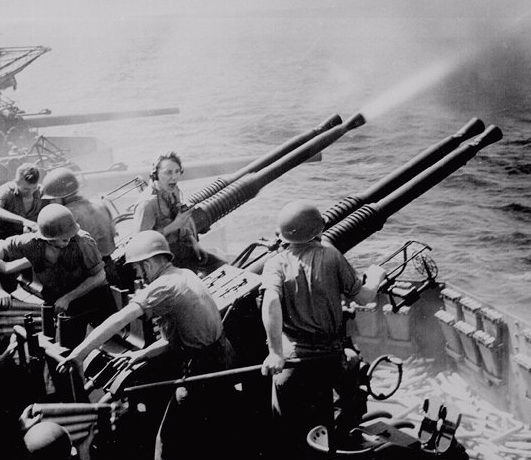
A good example of 40mm Bofor's in action
We are still shooting down planes of Japan death defying Kamikaze air force, which we call "Suicide" planes. A "Suicide" plane crashes into the bridge of the BB COLORADO, killing 19 men. our air coverage has never shown up and we hear that bad weather is hindering General MacArthurís P-38's, at about 1230 the air raids end, but before that, the wounded are already being brought in for care. One more alert before dark, but no attack this time. Sixteen of our shipmates were killed today. Unknown how many wounded at this writing.
Letter from Elmer J. Tolin GM3/c - 2509 43rd St. NW - Canton, Ohio 44709
I boarded CL-49 in May of 1943 / remained until September of "45". Was assigned to the 5th Div. top side gunnery, so naturally I witnessed all the top side action, I was top side on 40mm mount, port side when the Kamikaze plane missed our heads by inches and made the big hole in the fantail. the water spray was so heavy I thought we were over board. Before that I thought sure a plane was going to hit our stacks, when it suddenly flipped on its side and the wing tip slipped between the stacks with inches to spare. I still have a 4" piece of the plane with Jap writing on it. Lost all my gear and my bunk near the Post Office when we took the bomb hit at Green Island.
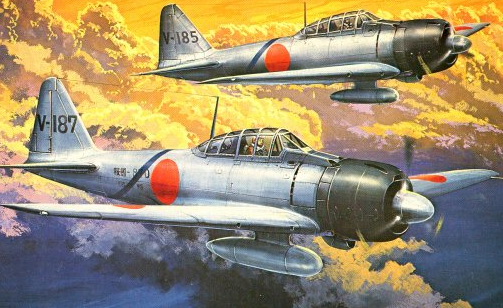
Carrier fighter (Zero) allied name "Hamp"
My first scary time was when securing the paint locker in the bow, we suddenly hit rough waters and the spray was so heavy I had batten down the hatch to keep from drowning. All alone their and it sounded like a great sledge hammer was pounding the sides, such rattling creaking and groaning, I thought the new bow was going to fall off, and no one would know what happened to me.
My happy days was firing the incinerator, a hot and dirty job no body wanted. Nosy me and one day I stumbled......... a crew and one officer whose name I can't remember anymore couldn't get a fire going only smoke, at age 22 I had R.R. engine experience, I recognized the problem where the water washed cinders clogged the smoke stack outlet so I resolved their problem. The officer offered me the job and I accepted with certain conditions. 3 HOT showers a day, ANYTIME, no swabbing decks or chipping paint. On off time I'd climb up between the stack on the potato crates to read and sleep. WHAT A DEAL..............
And shipmates HOW ABOUT SHANGHAI!!!!!!!!!!
Well that's another story
From: David Newman, 2786 Revere Dr. - Cuyahoga Falls, Ohio 44223
Son of Arvid L. Newman
Gun Crew member 1944-1945
Dear Mr. Jones
I was given your name and that of Phil Mills, to whom I'm also sending this
letter, by Mr. J. D. Huggins. My Dad was also a veteran of World War 11 who
served aboard the USS St. Louis. He served on the " Lucky Lou" from
July'44 to November'45. He was a 20mm gunner on the port side fantail, and was
wounded at Leyte Gulf when the Jap "Val" hit the fantail. I guess the
first thing I should ask is did you happen to know him? His name was Arvid L.
Newman, but he went by "Swede" for the most part in those days.
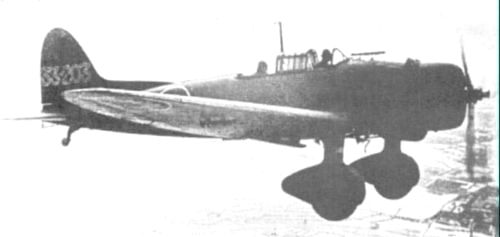
Japanese "Val" dive bomber
Pop was one of the gunners firing at Leyte. He told me he poured fire into that plane and cockpit. He said it came in and looked like it went straight up, rolled and came straight down behind them. He said something about hearing a Limey destroyer cut in front of the ship and caused them to stop or it might have missed the ship. The battle report says they were only making about 10 knots in a clockwise turn when they were hit, but doesn't mention any destroyer.
He said There were 16 of us back there that day and only 3 of us lived and we were carried off. He said the VAL was coming in hard and right at the fantail. Most of the guys back there began to scatter for cover. I guess he figured if he kept trying to knock it down he had a better chance, so he kept firing. it worked out that way because he came through it a little tore up but in one piece.
The others guys never found cover but many ran into the crashing plane. He remembered pulling out a phone cord and tying it on the arm of the guy on the gun with him. His fingers were just hanging by the skin. Dad must have passed out right after that. He said it blew him out of his shoes and a piece of shrapnel about the size of a CD split the seam of his life jacket and followed inside the layers to come out the middle of his back, never scratching him.
The last time we talked about it was Nov 27, 1994, the fiftieth anniversary of the battle. I had read a book at the library that mentioned the date and time of 1138hrs just a few days before and it was still fresh in my mind.. I had stopped to have coffee with my folks and noticed it was about 1130. I asked if he remembered what he was doing 50 years ago and he thought for a second and said," I was overseas I guess." I said You were about to be blown up at Leyte in about 10 minutes." He remembered and talked about it for a while. When he ended he said in a kind of quiet voice, "We lost a lot of men that day." He always wondered why them and not him.
He passed away the following April 5th, 1995. I've been researching the ship a little. We were best friends so we spent a lot of time together, and talked at length about his wartime experiences. I still remember him pulling out small pieces of shrapnel when I was a small boy. I was always interested in what he told me, and I guess it's something I want to pass on to my son. I don
=t think any of you should be forgotten, or any of the sacrifices you made that gave me a place to live in freedom.I finally found a model kit for the St. Louis at a place called the Floating Dry-dock in Pennsylvania. It is of the 1942 fitting, so some of the AA mounts are different than they were when Pop was on it. I've been getting some help from another of your shipmates named Jesse Walker, and it is just about finished. I just have a couple more 20mm's to put on.
Mr. Huggins said that Mr. Mills might be able to send me a directory of your association, so I asked him in the letter I wrote him. I would like to see if I recognize any of the names from some of the stories Dad told me, and maybe get in touch with them. I would especially like to find a guy named Eddie Niziolek from the Chicago area. He found my Dad laid out under a canvass with some other guys who were killed in the action , saw him breathe and got him help. He probably saved his life and I'd like to thank him for that.
I've been putting all I can find in the way of pictures and stories he told in a scrapbook to give my son. If any of you knew my Dad, I'd love to hear from you and add your letter to my book. I'd also appreciate any help in finding anyone who might remember him.
When I was a boy I remember being really impressed by his ribbons and Purple Heart Medal the first time I saw them. He was my hero and I loved to hear the stories he sometimes told. When I grew up and learned what all those things really meant and I heard some stories he had told no one else but Mom, I really understood why he should always be my hero.
Thanks for your time and help. I look forward to hearing from you, and please feel free to give my address to anyone interested.
Sincerely,
Dave Newman
2117 15th Street
Cuyahoga Falls, OH 44223
Dave Newman - 2117 15th St. - Cuyahoga Falls, OH 44233
Dear Dave,
More information concerning the battle in which your Dad was wounded. I am dragging this out of records accumulated by myself as editor for our ships paper the Hubble-Bubble.
In mid-October, she steamed back to Hawaii; trained until the end of the month; then moved on across the Pacific, via Ulithi and Kossol Roads, to the Philippines, arriving in Leyte Gulf on 16 November.
During the next ten days, she patrolled in the gulf and in Surigao Strait, adding her batteries to the antiaircraft guns protecting shipping in the area. Shortly before noon on the 27th, a formation of 12 to 14 enemy planes attacked the cruiser's formation. St. LOUIS was unscathed in the brief battle. A request was made for CAP cover, but Japanese planes continued to command the air. At 1130, another 10 enemy planes filled the space vacated by the first flight and broke into three attack groups of four, four, and two. At 1138, a Val, hit and aflame, made a suicide dive on St. Louis from the port quarter and exploded with its bomb on impact. Fires broke out in the cruiser's hanger area and spaces. All crew members of 20 millimeter guns 7 through 10 were killed or wounded.

"Val" Dive bomber
At 1139, a second burning enemy plane headed at her on the port beam. Flank speed was rang up and the rudder was put hard right. The plane passed over number 4 turret and crashed 100 yards out.
At 1146, there was still no CAP cover over the cruiser's formation; and, at 1151, two more enemy planes, both burning, attacked St. LOUIS. The first was splashed off the port quarter; the second dove in from starboard and crashed almost on board on the port side. A 20-foot section of armor belt was lost and numerous holes were torn in her hull. By 1152, the ship had taken on a list to port.
At 1210, another suicide-minded Japanese pilot closed St. LOUIS. He was stopped 400 yards astern. Ten minutes later, enemy torpedo planes moved in to attack. St. LOUIS warned by a PT boat, barely avoided contact with a lethal package dropped by one of the planes.
By 1236, the cruiser was back on even keel. Thirty minutes later, all major fires were out; and salvage work had been started. Medical work was well under way; 15 were dead, 1 was missing; 21 were seriously wounded; 22 sustained minor injuries. On the 28th, the seriously injured were transferred; and, on the 30th, she put into San Pedro Bay for temporary repairs which allowed her to reach California towards the end of December.
EXCERPT FROM: (Here comes the Marines!!!)
William Troy: Minneapolis, MN
This is a battle station experience on Nov. 27, 1944.
We were strafed in Leyte Gulf by diving Jap suicide planes. I was stationed on the 40 mm mount, port side forward and below the bridge. We were firing at incoming planes, as fast as the loaders could get the clips in, and we ran out of stored ammunition (remember the racks around the gun tubs). I instinctively jumped up a half deck to where the ammo was stored in canisters. Opening the canisters, I started handing the shells to the gun captain. As I was doing this, I noticed shells hitting the water near me, which was being fired from a Jap plane, I think it was a "Betty" bomber that was directly overhead.
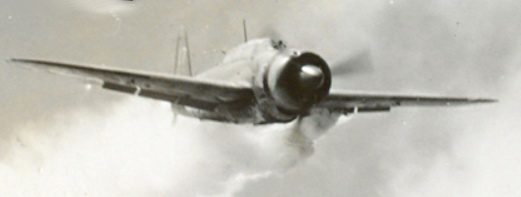
Jap "Hamp" hit and burning
Soon after, a Jap plane that we were firing at lost a wing and hit our port side bow, about 18 feet directly below our gun mount. It knocked off 15 foot of armor plating and penetrated the armory. Soon after this we took a kamikaze on the fantail just aft of No 5 turret. The explosion of its bomb brought our bow out of the water. I thought we were going to sink, but of course "The Ole Lucky Lou" survived
As remembered by Harry E. "HEP" Price - 28561 Hardiman Rd. Madison, AL - 35756
Early morning, November 28, 1944. Leyte Gulf in the Philippines.
The St. Louis was on patrol in the inner circle of a 50 mile wide formation. I am at general quarters as we were to refuel. My general quarter station was Repair Party #3 as a telephone operator to the bridge. Repair Party #3 station was located on the 2nd deck aft one compartment forward of the Chiefs' quarters. SUDDENLY! Over the telephone came a report of six (6) Japanese planes diving towards the St. Louis. I relayed this message to the OIC of Repair Party #3. He immediately took over the telephone and told me to go to my secondary battle station. My secondary battle station was assistant nozzle-man on the starboard 3" water hose. Tex Lobaugh, my best buddy, also a radioman, was the nozzle-man (6', 180 lbs). As I left the OIC to go to my station. a "Kamikaze" hit aft of the #5 turret and near the seaplane catapult.
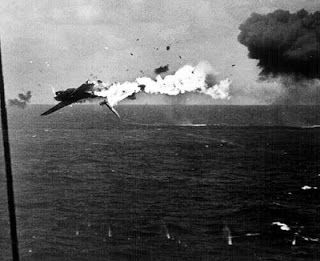
Above plane photo of Kamikaze going down
The concussion was deafening. The bunks and lockers in the crews compartment were falling all over the deck. The OIC gave our crew orders to open the bulkhead hatch to the Chiefs' quarters and check for fire, damage and casualties.
Lobaugh opened the hatch and smoke began to pour through the opening. The OIC said shut the hatch, which we did. Then, the OIC said turn on the water hose and then open the hatch. We did. As Lobaugh stepped over the hatch, he tripped and in doing so, he lost his grip on the nozzle. Now, can you see a 5'-six inch, 135 lb, 18 year old sailor trying to control the nozzle of a 3" high pressure water hose ?? this hose was slapping side to side in the doorway. Finally, after yelling for help, another man helped me get the hose under control. Lobaugh and I then, after donning gas masks, proceeded on into the Chiefs' quarters. The bunks on the starboard side were all smoking or smoldering, even though they were water proof, smoke completely filled the compartment. Fans were installed to dissipate the smoke and Lobaugh and I put out the smoldering fires on the bunks.
After the fires were put out and the smoke was cleared, I helped inspect the compartment for damage and casualties. Along with the fire damage to the bunks there was no electrical power. There was a huge bomb blasted hole through the aft compartment bulkhead, and into the elevator compartment that housed the seaplanes'
There was one casualty in the chiefs' head. John Marshall Powell, CMM. We called the medic and after he announced Powells' death the OIC told Lobaugh and I to take his body topside. AN EXPERIENCE!! It left me weak and shaky.
Following a brief rest and having received solace, inspection, chewing gum and a shot of intoxicating liquid from Chaplain Connolly, I continued to help clean-up the Chiefs' compartment. Later, I assisted in taking the body of Clyde Roe Boyd, ARM2c, USN from the hanger deck compartment to topside.
EXCERPT FROM: Stephen Polchert:
It was with great interest that I read about your (Hep's first battle Vol.4) first battle on the Lucky Lou. I came aboard about the same time you did in 1944. The morning you described is so vivid.
I was on watch in the aft engine room, Early that morning I was sent up to wake-up the watch. I went aft to the Chiefs' quarters and woke up Chief Powell. I knocked on his door and I heard him answer. I headed back to the engine room and, then I heard and felt the Kamikaze hit the ship. I was the last person to speak to Chief Powell. I surely prayed a lot aboard ship and I am certain it helped pull me through the war.
EXCERPT FROM: John Hinds: (Deceased)
"As a gunners-mate in the 5th Division manning the 1.1's, 20mm, and 40mm anti-aircraft guns, I had lots of training and watch standing,.....Yet..... when its time to shoot for real it's over in seconds, especially, when airplanes are involved.
I was first loader on a quad 40mm at Green Island. I suppose I may have put 6 or 8 clips (4 rounds to a clip) into the gun, when a bomb from a Val dive bomber went through the deck on our gun platform causing the ammunition in the ready room, under the gun, to start exploding just like a string of firecrackers. Later, the Captain came back to inspect the damage. He wanted to know who was sitting in the trainers' seat. One of the guys spoke up and said "He was". The Captain then replied. "If I were you, I would go to church Sunday or better yet, I would go before Sunday".
At Leyte Gulf we were at GQ. I was on the fantail 20mm, port side. We had gone through a lot of air alerts so I was not too shook-up, UNTIL....a plane made a run on a ship up ahead of us. After dropping his bomb, he was headed up and out, when he lost his vertical stabilizer. This caused him to go into an upside down spin until he hit the water. (One dizzy Jap when he died, I'll bet).
Right after this, I saw a group of planes at low altitude coming at us from the port side. I started firing. On the first magazine of 60 rounds, I hit one of the planes. He was on fire, but he kept coming. My first loader was jumping up and down and yelling "You got him" "You got him", and I had to tell him to put in another magazine because the gun was out of ammunition. This he did. I started firing again. Then a plane hit just aft of #5 Turret. I was not shooting at this plane. The plane that I hit was still coming, although he was burning real good. After we got hit there was a lot of fire and smoke emerging from the hole in the forward part of the hanger deck where the Kamikaze plane went in. I looked around and here comes the plane that was on fire. He was just about to the ship, and then he rolled upside down and came right over top of me. He was so close, we could feel the heat and hear the flames. He missed and went into the water on the starboard side. I was wounded in the head and body, but I helped the damage control and repair crew, then later I went down and got all bandaged up. To this day, I think, maybe I could of done better, but as I said before...."Its all over in seconds".
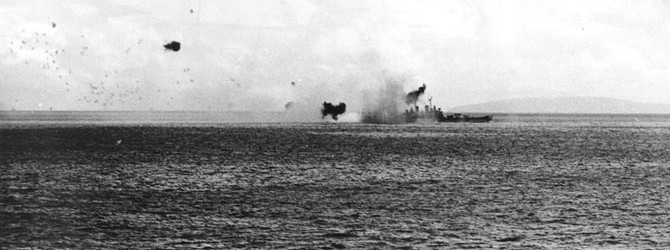
EXCERPT FROM: Harry W. Ames:
"In the battle of Philippines, the St. Louis sustained severe damage. 15 men and 1 officer were lost when a Japanese kamikaze hit on the forward part of the hanger deck. How lucky I was! I had just come up the ladder, and was sheltered by the starboard side of Turret #5. The Jap plane took out the ladder when it hit. I then helped pull the first fire hose to the hanger, then took over the repair party phones until relieved".
Letter from James D. Moon:
I went aboard the "Lou" on November 14, 1940 and served until August 10, 1945. Got off the ship at Okinawa a couple days before the Nips surrendered. While checking a back issue of the Hubble-Bubble ran across an excerpt from Harry W. Ames. He said that when we got hit in Leyte Gulf by the Kamikaze, he helped pull the first fire hose to the hanger deck and I want to say that he was helping me.
I was a Storekeeper aboard ship and my battle station was in the lower handling room of the #3 & #4 AA mounts until I went into the repair party.
I was in charge of Repair #1 on the bow the night the torpedo hit. And when the Kamikaze hit the hanger deck I was Chief in charge of Repair #1 on the bow and helped to get water to the fire in the hanger deck. I understand you were back in that part of the ship also. That's me holding the fire hose in one of the pictures in the U.S.S. St. LOUIS book. That fire hose came all the way from the bow of the ship and by the time I got to the hanger deck it was getting rather heavy.
Hope to see you in San Antonio and catch up on our war stories. Medlin, Pepper, Hosch, Pope and I were in Platoon #97 at Norfolk in 1940......
A story from "Swede" Newman
The St. Louis left Ulithi and proceeded to Leyte Gulf in the Philippine Islands via Kossol Roads in the Palau Islands, entering the gulf on 16 November 1944.During the next ten days they supported the landings and pulled picket duty patrolling the gulf and the Surigao Strait. In the 13 days from 16 November to29 November the St. Louis endured some 33 air attacks. The most devastating occurred as the noon chow line was forming at 1130 his., 27 November1944.
According to the Official Action Report, Anti Aircraft - 27 November 1944,the St Louis, in company with Task Group 77.2, was steaming in circle 3 clockwise at approximately 8 knots, in a circle formation of heavy ships, at a distance of about 3000 yards from the tanker, Caribou. She was in formation with cruisers Minneapolis, Denver, Columbia, Montpelier, battleships Colorado, New Mexico, West Virginia, Maryland. About 9 destroyers were circling in circle 5 counterclockwise at approximately 10 knots. The West Virginia was completing fueling as was a destroyer on the tanker's opposite side. The Denver had left the circle and was proceeding toward the tanker in preparation for following the West Virginia in fueling. At 1046 Maryland sent a "Flash Red, Control Green" message. At 1047 the heavy ship formation speed was increased to 15 knots and the destroyers proceeded to move into circle 3 between the heavy ships. (this may explain the scuttlebutt Dad heard about them being cut of a 'limey" destroyer causing them to slow to avoid a collision)
At about 1112 a "JUDY" dove out of the clouds slightly on the port bow of St. Louis, crossing from port to starboard and dropped a bomb about 800 yards two points abaft the St. Louis starboard beam and about 300 yards off the starboard quarter of the Denver. This plane, when pulling out of its dive carried away some portion of its tail, went into a flat spin and crashed about 1500 yards well aft on the starboard side of St. Louis.
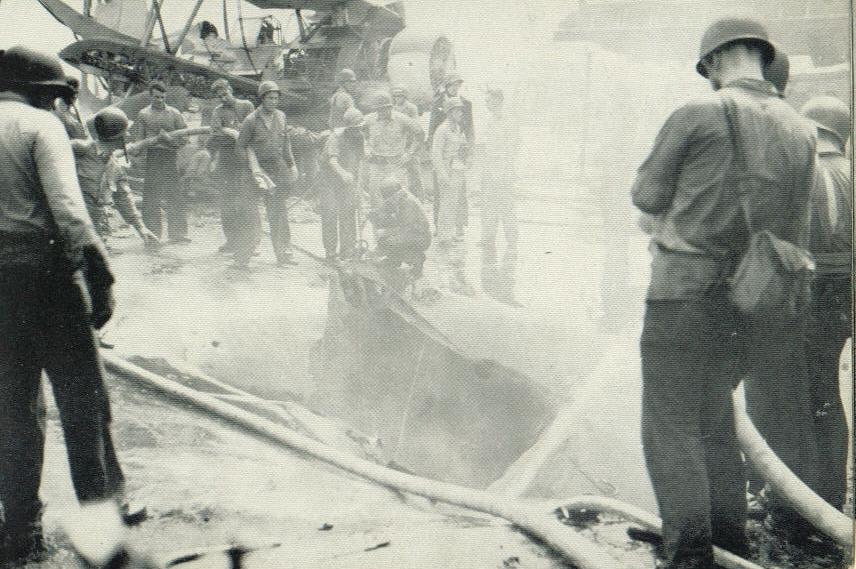
To the men left on the fantail the "Lucky Lou" didn't seem so lucky this day. The plane struck behind Dad and killed15 enlisted men and 1 officer. Everyone who scattered for cover ran into the crashing plane's area and was killed. Below in the chiefs head a man was killed. Some were killed in the hanger deck Two men (Raymond Graysneck - 612 Campbell - Ardmore, OK and Verl Kelly -115 N. Claremont St., Colorado Sprgs. CO ) who were sitting. action watching, under the catapult were blown overboard and were recovered from the sea by the destroyer Waller, wounded but alive. One man named Butterworth was missing inaction. A man named Goulson ducked behind an ammo box and a piece of shrapnel took off the top of his head. In 5" 38 mount #3 two shell men were killed, and 75% of the crews of 20 mm mounts 7 through 10 were killed or incapacitated. Amazingly, these casualties were quickly replaced, the crews reorganized, and the guns continued in action. Dad said he thought only three men lived on the fantail that day, and they were carted off.
He said he was literally blown out of his shoes. He didn't tie them so he could get them off easier if he went overboard. He suffered numerous shrapnel wounds. He thought he had lost his eye when it filled with blood from a wound over it, his thumb looked like it was gone from the blood all over it and he had a piece in his hip that was never able to be removed for fear it would leave him with a stiff leg. He told me apiece about 4" in diameter entered the seam in the front of his life jacket, went around him between the layers of material and came out the middle of his back without even scratching him.
The guy with him was holding his wrist with his fingers dangling by the skin and was saying, "Swede look at my hand. Look at my hand Swede. " The last thing Dad remembered was pulling out a phone line and tying a tourniquet with the cord for him. He passed out from the loss of blood.
Dad must have looked bad because they had him laid out under a canvass with the "rest" of the dead. He had a friend named Eddie Niziolek, a gun-striker whose battle station was somewhere in the forward end. Eddie was from the Loop in Chicago, and he came on board the same day as Dad. Dad used to talk about Eddie's mother sending cakes and other goodies to him which he shared with Dad. They had made an agreement earlier that if anything happened to one of them the other would find them and see that the family knew what happened. Eddie knew Dad's battle station was near the damage and went looking for him. Figuring he was dead when he couldn't find him, he began lifting the canvass and looking at the bodies. When he saw Dad he saw him move or breathe and immediately hollered, "This one is alive!" He got him medical attention and he was taken to the chiefs mess where he was promptly forgotten for another 3 days. I often wondered if Eddie Niziolek had not found him would they have buried him at sea? Our family will be forever thankful to Eddie Niziolek.
I was able to find Ed Niziolek Jr. in Morton Grove, Illinois in July of 1999. His father was the man who found Dad. His father had passed away in 1984, but Ed was delighted to hear the story of his father's deed We have been exchanging stories and photos over the Internet and telephone.
On the third day Dad remembers, that he awoke in great pain with his leg swollen twice its normal size from the shrapnel in his hip. He began pounding on the bulkhead and hollering. A Chief Pharmacist's Mate heard him and came in and found him. He said, "What the hell are you doing in here?" Dad said he didn't know why he was there. The chief gave him a shot and started working on him. He never made it to a hospital ship, but remained on board until he healed up.
There were 21 seriously wounded, 22 sustained minor injuries, and some 31were hospitalized at one point, in addition to the 16 dead. Of the twelve planes sighted during this part of the Leyte action, 9 were taken under fire by the gun crews of the St. Louis, 6 of which were attacking the St. Louis herself. Of those 6 attacking, 4 were downed by the ship herself and she assisted in knocking down the other 2. Of the other 3 which the St. Louis took under fire, it was listed as a sure assist.
Excerpts from :....................
Verle Kelly, 115 N. Claremont St., Col. Springs. CO 80909
Ph. (719) 633-6333
Hi Jack,
In answer to your question in your letter to me, the third man blown off the
ship was Charlie Butterworth, he didnít make it, and his body was picked up
later.
Ray (Graysneck) and I were crouched under the catapult when we saw the plane coming in, we were right by the life raft under the catapult.
I remember I felt the heat and concussion from the explosion (we were only about 25-30 feet) from where the plane hit, and the next thing I knew we were floating around and treading water as neither of us had a life jacket on.
We found a piece of the life raft about 1-2 ft square, so we both hung onto that until we were picked up. (We had just about given up on that) If it hadnít been for my old buddy "Ray", I wouldnít of made it.
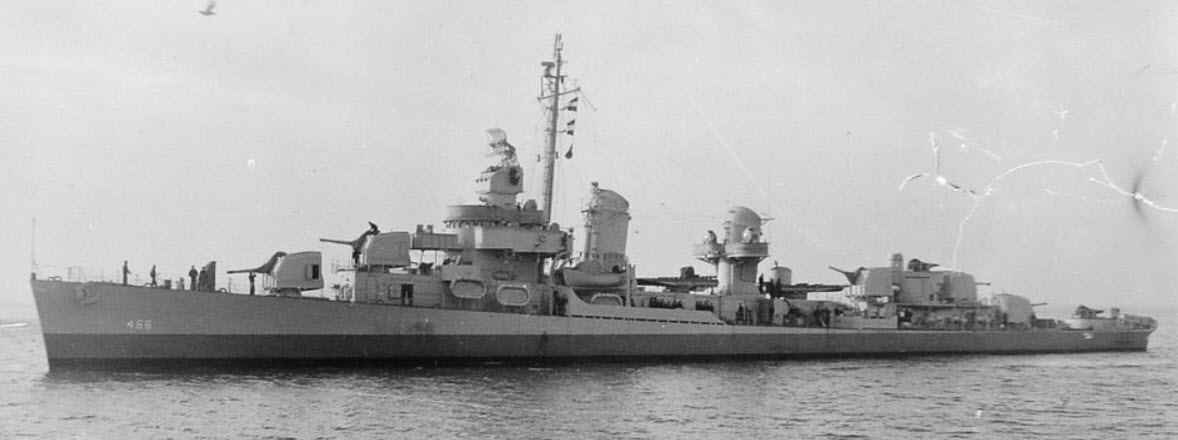
Waller DD-466 -- 1942
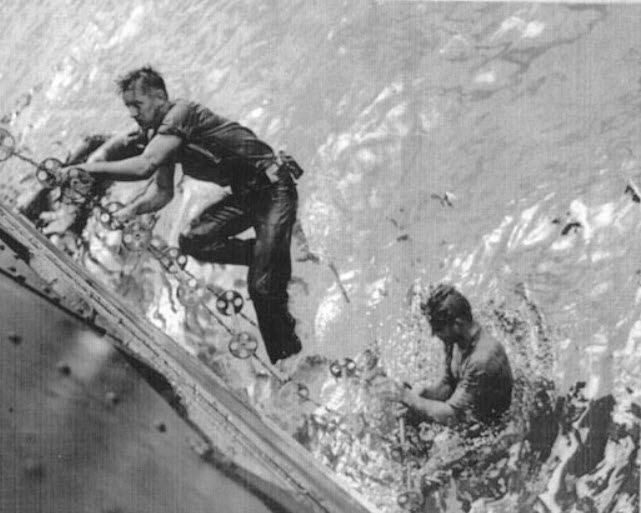
Graysneck ( on Ladder) Kelly (in Water
The Destroyer "Waller" picked us up and doctored us on board. That night they made a run up close to the beach and knocked off a Japanese sub there and we hauled out of there. Those Destroyer people have a lot of guts.
Then next day or two they put us aboard a temporary hospital ship, where we stayed a few days, and from there to a regular hospital ship and on down to New Caledonia, down by Australia. I was there 3 months doctoring for burns and shrapnel - Donít know where Ray was sent.
I later caught up with the St. Louis at Okinawa and was soon underway again in the war. Ray was already there.
Will be thinking of all you at Tampa, see you next year I hope.
As always, Verle and Donna